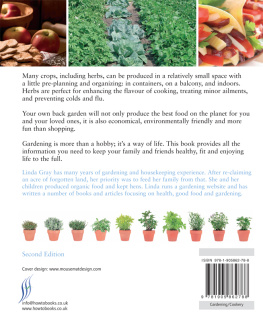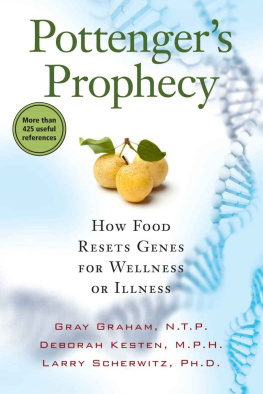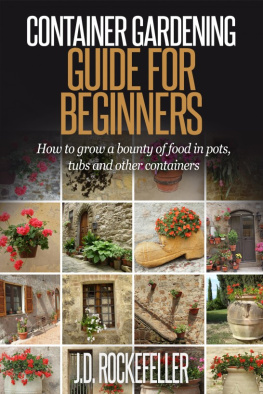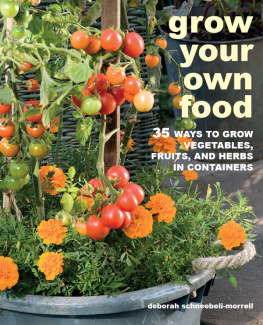At www.howto.co.uk you can engage in conversation with our authors all of whom have been there and done that in their specialist fields. You can get access to special offers and additional content but most importantly you will be able to engage with, and become a part of, a wide and growing community of people just like yourself.
At www.howto.co.uk youll be able to talk and share tips with people who have similar interests and are facing similar challenges in their lives. People who, just like you, have the desire to change their lives for the better be it through moving to a new country, starting a new business, growing their own vegetables, or writing a novel.
At www.howto.co.uk youll find the support and encouragement you need to help make your aspirations a reality.
You can to direct to www.grow-your-own-groceries.co.uk which is part of the How To site.
Grow it! Cook it!
The beginners guide to producing your own food
Linda Gray

Published by Spring Hill
Spring Hill is an imprint of How To Books Ltd
Spring Hill House, Spring Hill Road,
Begbroke, Oxford, OX5 1RX, United Kingdom
Tel: (01865) 375794 Fax: (01865) 379162
www.howtobooks.co.uk
How To Books greatly reduce the carbon footprint of their books by sourcing their typesetting and printing in the UK.
All rights reserved. No part of this work may be reproduced or stored in an information retrieval system (other than for the purposes of review), without the express permission of the Publisher given in writing.
The right of Linda Gray to be identified as author of this work has been asserted by her in accordance with the Copyright, Designs and Patents Act 1988.
2012 Linda Gray
First edition 2009
Reprinted 2009
Second edition 2012
British Library Cataloguing in Publication Data
A catalogue record for this book is available from the British Library
ISBN: 978 1 905862 78 8
Produced for How To Books by Deer Park Productions, Tavistock
Illustrations by Rebecca Peacock
Typeset by TW Typesetting, Plymouth, Devon
Printed and bound in Great Britain by Bell & Bain Ltd, Glasgow
NOTE: The material contained in this book is set out in good faith for general guidance and no liability can be accepted for loss or expense incurred as a result of relying in particular circumstances on statements made in this book. Laws and regulations may be complex and liable to change, and readers should check the current position with the relevant authorities before making personal arrangements.
INTRODUCTION
Producing your own food and other household groceries is not only extremely rewarding but, in times of economic and environment changes, a must!
Gardening has, until recent years, been a way of life and a necessary commitment if families were to survive and grow. Nature provides everything the human body requires to survive, and cultivating some of those natural products in our own back garden will not only produce the best food on the planet for our loved ones, it is also economical and environmentally friendly.
Chemicals dont have to be used to produce perfectly shaped strawberries, petrol is not required to drive into your back garden to collect your food and, not only that, as you are exercising and getting a dose of fresh air every day, gym subscriptions and doctors visits will be a thing of the past.
Many crops can be produced in containers and in a relatively small space with a little pre-planning and organising. And many of these crops can be employed in different ways. Herbs are perfect for collecting brownie points for your culinary skills. They can also treat minor ailments and prevent colds and flu. Rather than getting a cold virus and passing it round and round the household, refuse to allow it into the house in the first place, by keeping healthy and strong. No more vitamin supplements or cold remedies to buy!
Grow It! Cook It! provides all the information you need to keep your family and friends healthy and enjoying life to the full. Gardening is more than a hobby, its a way of life and neednt mean back ache and boring garden chores. Even without a garden, many plants can be grown in containers, on a balcony and indoors.
Get those wellies on and produce the best groceries in the world for your family and friends and keep fit and healthy while youre doing it. Grow It! Cook It! will reduce your shopping bill, remove the supermarket stress, and take you and your family into a healthier future.
CHAPTER 1
THE SALAD BOWL
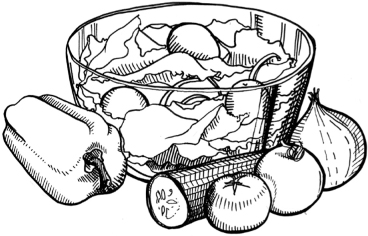
A bowl of mixed salad is one of the healthiest, easiest and tastiest meals you can prepare for you and your family. Kids dont always appreciate green leafy vegetables, but chopped lettuce stirred into a bowl of colourful peppers and tomatoes always goes down a treat!
Growing salad ingredients couldnt be easier and many can be grown indoors, in a conservatory or even a window box, as well as outside in a traditional garden. If you have a conservatory or greenhouse, salad can be grown almost all year round although, as its eaten raw and often cold, other veggies can be eaten during the cooler months of the year. Eating seasonally is a good rule of thumb when balancing a healthy diet.
This chapter covers five main ingredients of a nutritious and delicious salad bowl:
- tomatoes
- lettuce
- cucumber
- peppers
- onions.
There are many other vegetables you can add as and when you have them available:
- carrots grated or finely sliced
- garlic crushed or finely chopped
- mange tout whole or cut in half
- fresh peas or beans cooked and then cooled
- herbs and edible flowers
- nuts and seeds.
Prepare your salad as close to meal time as possible. As soon as you start cutting vegetables, they begin to lose some of their vitamin content. However, picking your salad from the garden in the afternoon and eating it in the evening is a lot better than buying tired, old looking vegetables from the supermarket.
If your little darlings refuse to eat anything that doesnt come out of a packet, you could try tipping the tomatoes into a freezer bag on the quiet and then make a big deal about getting them out of the fridge later. Or even better, get them involved in the garden.
TOMATOES
About tomatoes
There is evidence that the Incan civilisation grew tomatoes as a food crop but over the centuries the tomato was grown as an ornamental plant because the fruits were thought to be poisonous.
By the early nineteenth century the tomato was once again considered a worthy food crop and businessmen ate tomatoes in public places to prove the fruit was in fact edible and could be safely consumed. The earliest recorded tomato ketchup recipe was developed in 1818.
Because tomato plants are self-pollinating, they tend not to change the components of their particular variety very much, which means we have many heirloom varieties available today, as well as many new hybrids in all sorts of shapes and colours.

